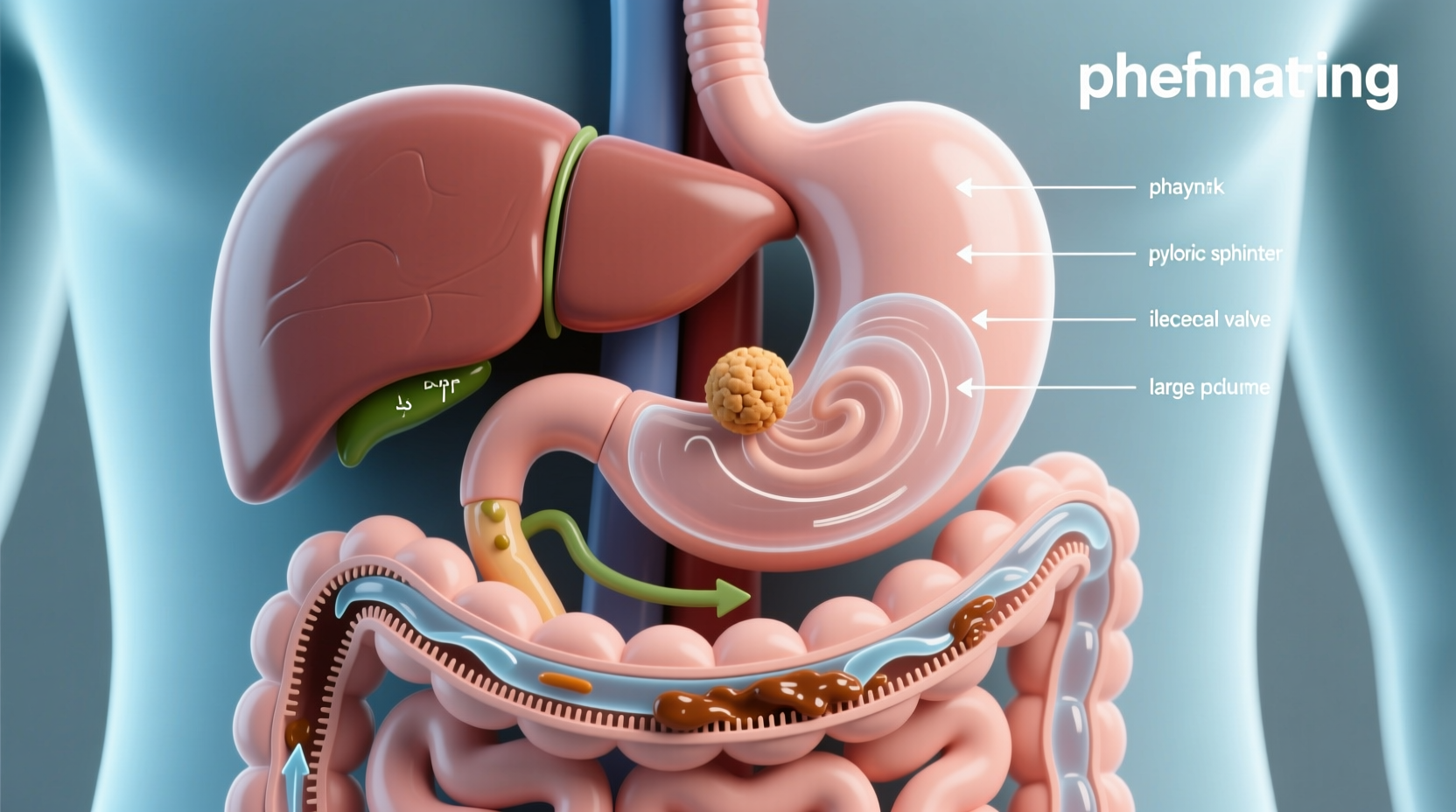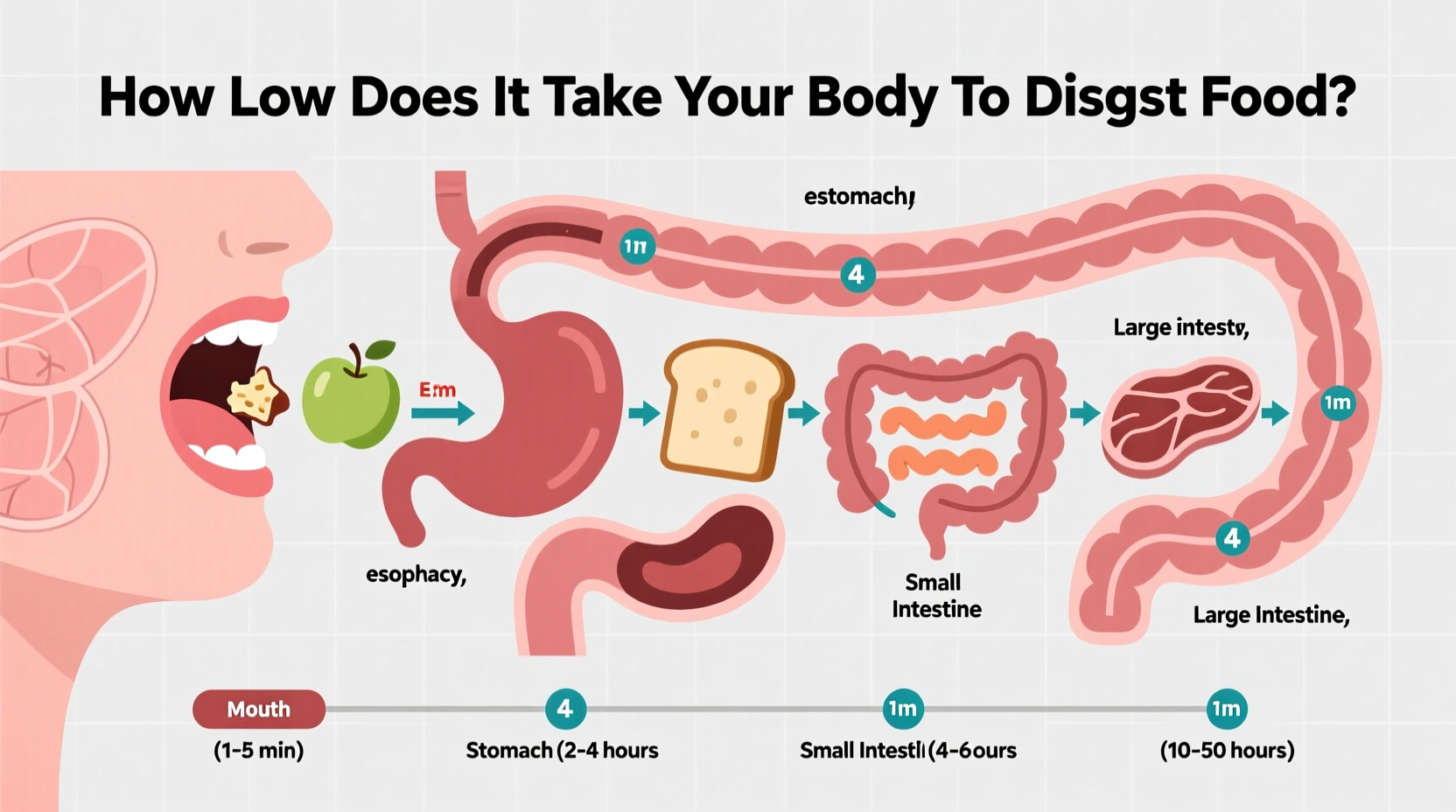Ever wonder why you feel full for hours after a steak dinner but hungry again shortly after a sugary snack? Understanding your body's digestion timeline helps optimize meal planning, manage digestive issues, and improve overall wellness. This comprehensive guide reveals evidence-based digestion timelines, factors affecting your personal digestion speed, and practical strategies to support healthy digestive function.
The Digestive Journey: What Happens Inside Your Body
Your digestive system works like a precision-engineered assembly line, breaking down food through mechanical and chemical processes. When you eat, digestion begins immediately in your mouth with chewing and saliva enzymes. Food then travels down the esophagus to your stomach, where powerful acids and enzymes continue the breakdown process. From there, partially digested food moves to the small intestine for nutrient absorption, then to the large intestine for water extraction before elimination.
According to the National Institute of Diabetes and Digestive and Kidney Diseases (NIDDK), the digestive process involves coordinated muscle movements and specialized enzymes working in sequence. This sophisticated system adapts to different food types, which explains why digestion times vary significantly based on what you eat.
Digestion Timeframes by Food Type
Not all foods digest at the same rate. Your body processes different macronutrients at varying speeds, affecting how long you feel full and how quickly energy becomes available. Here's a breakdown of typical digestion times for common food categories:
| Food Type | Stomach Emptying Time | Total Digestion Time | Key Characteristics |
|---|---|---|---|
| Water | Immediate | 0-20 minutes | Absorbed directly through stomach lining |
| Simple Carbohydrates (Fruits, Sugars) | 30-60 minutes | 2-3 hours | Quick energy source, rapid digestion |
| Complex Carbohydrates (Whole Grains) | 1-2 hours | 3-4 hours | Fiber slows digestion, provides sustained energy |
| Proteins (Meat, Fish, Eggs) | 2-4 hours | 4-6 hours | Requires extensive enzymatic breakdown |
| Fats (Oils, Avocado, Nuts) | 3-6 hours | 6-8+ hours | Slows gastric emptying, longest digestion time |
| High-Fiber Foods (Vegetables, Legumes) | 2-3 hours | 12-24+ hours | Fiber moves slowly through large intestine |
This timeline comes from research published by the American Gastroenterological Association, which tracks gastric emptying rates using specialized imaging techniques. Their studies show that mixed meals typically follow a predictable pattern: carbohydrates digest fastest, followed by proteins, with fats taking the longest.
Key Factors That Influence Your Personal Digestion Timeline
While general digestion timelines provide helpful benchmarks, your personal experience depends on multiple factors. Understanding these variables helps explain why digestion times differ between individuals and even day-to-day for the same person.
Food Composition Matters Most
The specific combination of macronutrients in your meal significantly impacts digestion speed. Meals high in fat and protein take longer to digest than those rich in simple carbohydrates. Harvard Medical School research shows that adding healthy fats to a carbohydrate-rich meal can slow gastric emptying by 30-50%, helping you feel full longer. This explains why a bowl of sugary cereal digests much faster than oatmeal with nuts and seeds.

Your Body's Unique Physiology
Individual factors play a crucial role in digestion timing. Age affects digestive efficiency, with older adults often experiencing slower gastric emptying. Gender differences exist too—women typically have slower gastric emptying than men, particularly during certain menstrual cycle phases. The Mayo Clinic notes that digestive transit time can vary by as much as 30% between individuals with similar diets.
Lifestyle and Health Conditions
Your daily habits directly impact digestion speed. Regular physical activity stimulates intestinal contractions, speeding up transit time. Chronic stress triggers the body's "fight or flight" response, which diverts blood flow away from digestion. Certain health conditions like irritable bowel syndrome (IBS), diabetes, and thyroid disorders can significantly alter normal digestion patterns. The National Institutes of Health confirms that digestive disorders affect nearly 60 million Americans, often altering standard digestion timelines.
Recognizing Healthy Digestion Patterns
How can you tell if your digestion timeline falls within healthy parameters? Understanding normal digestive patterns helps identify potential issues early. Most adults experience bowel movements anywhere from three times daily to three times weekly, with stool consistency providing important clues about digestive health.
Signs of healthy digestion include:
- Regular bowel movements without straining
- Stool that maintains shape but isn't hard (Bristol Stool Scale types 3-4)
- Minimal gas or bloating after meals
- Consistent energy levels without post-meal crashes
- No persistent abdominal pain or discomfort
Conversely, warning signs that warrant medical attention include:
- Chronic diarrhea (three or more loose stools daily for over two weeks)
- Severe constipation (fewer than three bowel movements weekly with discomfort)
- Blood in stool or black, tarry stools
- Unexplained weight loss with digestive changes
- Persistent abdominal pain that disrupts daily activities
Practical Strategies to Support Optimal Digestion
While you can't fundamentally change your digestive physiology, several evidence-based approaches can help optimize your digestion timeline and comfort:
Meal Timing and Composition
Structure your meals to support steady digestion. Start with fiber-rich foods to slow carbohydrate absorption, and pair proteins with healthy fats for sustained energy release. The American College of Gastroenterology recommends eating smaller, more frequent meals if you experience slow digestion, as large meals can overwhelm your digestive system.
Hydration and Movement
Adequate water intake supports healthy digestion—aim for half your body weight in ounces daily. Gentle movement after meals, like a 10-15 minute walk, stimulates intestinal contractions without diverting blood flow from digestion. Research in the Journal of Gastroenterology and Hepatology shows that post-meal walking can improve gastric emptying by 15-20% in healthy adults.
Dietary Adjustments for Common Issues
If you experience specific digestive challenges, targeted dietary changes can help:
- For slow digestion: Increase soluble fiber gradually, add fermented foods, and consider digestive enzyme supplements
- For fast digestion: Incorporate more healthy fats and protein, reduce simple sugars, and eat more slowly
- For bloating: Try low-FODMAP foods, chew thoroughly, and avoid carbonated beverages
When to Consult a Healthcare Professional
While occasional digestive variations are normal, persistent changes warrant professional evaluation. The American Gastroenterological Association recommends seeking medical advice if you experience:
- Digestive symptoms lasting more than two weeks
- Symptoms that interfere with daily activities
- Unexplained changes in digestion patterns
- Family history of digestive disorders
Diagnostic tests like gastric emptying studies, colonoscopy, or breath tests can identify specific issues affecting your digestion timeline. Early intervention often leads to better outcomes for digestive health conditions.
Final Thoughts on Digestion Timelines
Understanding how long food takes to digest provides valuable insights for optimizing your diet and recognizing potential health issues. Remember that digestion isn't just about time—it's about quality of breakdown and nutrient absorption. By paying attention to your body's signals and making informed dietary choices, you can support healthy digestion at any age.











 浙公网安备
33010002000092号
浙公网安备
33010002000092号 浙B2-20120091-4
浙B2-20120091-4